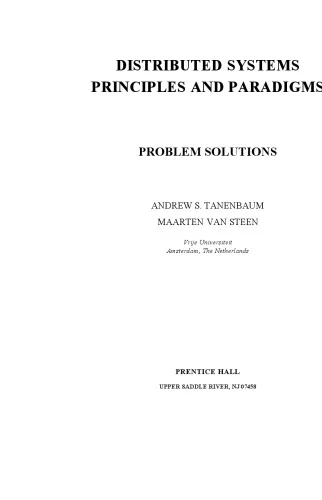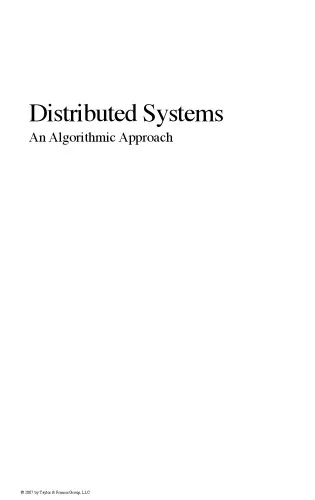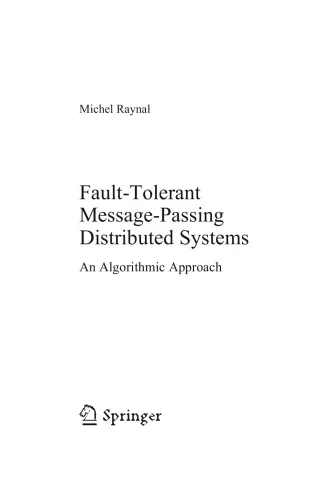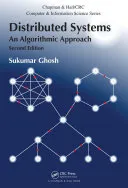Patterns of Distributed Systems
4.8
Reviews from our users

You Can Ask your questions from this book's AI after Login
Each download or ask from book AI costs 2 points. To earn more free points, please visit the Points Guide Page and complete some valuable actions.Related Refrences:
Persian Summary
Introduction to Patterns of Distributed Systems
As we navigate the complexities of modern software development the importance of distributed systems cannot be overstated. With the rise of cloud computing microservices and edge computing the need for scalable resilient and maintainable systems has never been more pressing. In "Patterns of Distributed Systems" I Unmesh Joshi aim to provide a comprehensive guide to designing and building distributed systems that meet the demands of today's fast-paced digital landscape.
Detailed Summary of the Book
"Patterns of Distributed Systems" is a book that delves into the world of distributed systems exploring the principles patterns and practices that underlie the design and development of these complex systems. The book is divided into several sections each focusing on a specific aspect of distributed systems.
The book begins by introducing the fundamentals of distributed systems including the challenges and benefits of building distributed systems. It then delves into the various patterns and principles that govern the design of these systems including scalability availability and maintainability.
The book also explores the different types of distributed systems including client-server systems peer-to-peer systems and microservices-based systems. It discusses the trade-offs and challenges associated with each type of system and provides guidance on how to choose the right approach for a given problem.
In addition to the theoretical foundations of distributed systems the book also provides practical guidance on how to design and build these systems. It covers topics such as communication protocols data consistency models and fault tolerance strategies providing concrete examples and case studies to illustrate key concepts.
Throughout the book I draw on my own experience as a software engineer and architect as well as the experiences of other experts in the field. The result is a comprehensive and authoritative guide that provides readers with the knowledge and skills they need to design and build distributed systems that meet the demands of today's fast-paced digital landscape.
Key Takeaways
Some of the key takeaways from "Patterns of Distributed Systems" include
- A deep understanding of the principles and patterns that govern the design of distributed systems
- Knowledge of the different types of distributed systems and the trade-offs associated with each
- Guidance on how to choose the right approach for a given problem
- Practical advice on how to design and build distributed systems including communication protocols data consistency models and fault tolerance strategies
- Concrete examples and case studies to illustrate key concepts
Famous Quotes from the Book
Here are a few quotes from "Patterns of Distributed Systems" that capture the essence of the book
"Distributed systems are not just about scaling they are about building systems that can withstand the test of time and uncertainty."
"The key to building successful distributed systems is to understand the trade-offs and make conscious decisions about the design and architecture of the system."
"Distributed systems are not just about technology they are about people and process. It's about building teams that can work together to design and build systems that meet the needs of the business."
Why This Book Matters
"Patterns of Distributed Systems" matters because it provides a comprehensive and authoritative guide to designing and building distributed systems. In today's fast-paced digital landscape the need for scalable resilient and maintainable systems has never been more pressing. This book provides readers with the knowledge and skills they need to meet this challenge.
The book is written for software engineers architects and technical leaders who want to build distributed systems that meet the demands of today's digital landscape. It's also for anyone who wants to learn about the principles and patterns that govern the design of distributed systems.
By reading "Patterns of Distributed Systems" readers will gain a deep understanding of the principles and patterns that govern the design of distributed systems. They will learn how to choose the right approach for a given problem and how to design and build systems that meet the demands of today's fast-paced digital landscape.
Free Direct Download
You Can Download this book after Login
Accessing books through legal platforms and public libraries not only supports the rights of authors and publishers but also contributes to the sustainability of reading culture. Before downloading, please take a moment to consider these options.
Find this book on other platforms:
WorldCat helps you find books in libraries worldwide.
See ratings, reviews, and discussions on Goodreads.
Find and buy rare or used books on AbeBooks.
Questions about Book
5600
بازدید4.8
امتیاز4
نظر98%
رضایتReviews:
4.8
Based on 4 users review
massoud
Dec. 1, 2023, 9:29 p.m.
I heard about it from Nabi's Telegram channel. It's a valuable book for software engineers.
shruti
Oct. 3, 2024, 2:06 p.m.
explanatory
namrata7
June 15, 2025, 10:06 a.m.
a very good for the given topic
siddharth7
Oct. 26, 2025, 12:05 p.m.
excellent book for distributed systems
Questions & Answers
Ask questions about this book or help others by answering
No questions yet. Be the first to ask!

































